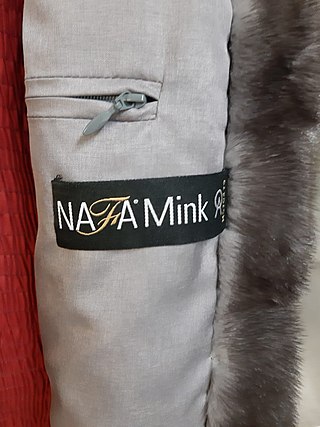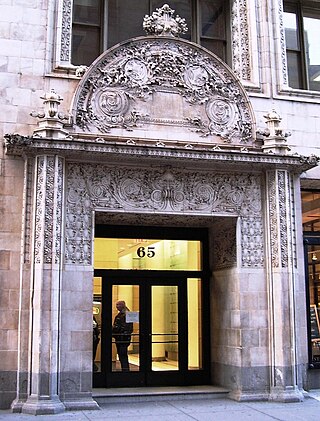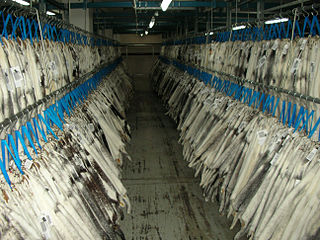
The economy of Denmark is a modern high-income and mixed economy.

Fur farming is the practice of breeding or raising certain types of animals for their fur.

The fur trade is a worldwide industry dealing in the acquisition and sale of animal fur. Since the establishment of a world fur market in the early modern period, furs of boreal, polar and cold temperate mammalian animals have been the most valued. Historically the trade stimulated the exploration and colonization of Siberia, northern North America, and the South Shetland and South Sandwich Islands.

Rabbit hair is the fur of the common rabbit. It is most commonly used in the making of fur hats and coats, and is considered quite valuable today, although it was once a lower-priced commodity in the fur trade.

Fur clothing is clothing made from the preserved skins of mammals. Fur is one of the oldest forms of clothing and is thought to have been widely used by people for at least 120,000 years. The term 'fur' is often used to refer to a specific item of clothing such as a coat, wrap, or shawl made from the fur of animals.

North American Fur Auctions is a Canadian company that auctions on consignment fur pelts harvested in Canada and the United States. Its services are used by both large fur farms and small-time trappers. Its auctions are held three to four times a year in Toronto. It is the largest fur auction house in North America, and the second largest in the world.

The Council of Fashion Designers of America, Inc. (CFDA), founded in 1962 by publicist Eleanor Lambert, and headquartered in Manhattan, is a not-for-profit trade association comprising a membership of over 450 American fashion and accessory designers. The organization promotes American designers in the global economy.

The short-tailed chinchilla is a small rodent part of the Chinchillidae family and is classified as an endangered species by the IUCN. Originating in South America, the chinchilla is part of the genus Chinchilla, which is separated into two species: the long-tailed chinchilla and the short-tailed chinchilla. Although the short-tailed chinchilla used to be found in Chile, Argentina, Peru, and Bolivia, the geographical distribution of the species has since shifted. Today, the species remains extant in the Andes mountains of northern Chile, but small populations have been found in southern Bolivia.
The American Legend Cooperative (ALC) was an agricultural marketing cooperative of mink fur farmers in the United States and Canada, best known for its Blackglama, American Legend brands of fur, as well as the older LEGEND brand. American Legend was formed in 1986 as a merger of the Great Lakes Mink Association (GLMA) and the Mutation Mink Breeders Association (EMBA). It was acquired by North American Fur Auctions in 2018.

KWH Group Ltd is a Finnish family-owned company based in Ostrobothnia that manufactures and markets abrasives and plastic products and provides forwarding and logistics services, including cold storage of food. The company was formed in 1984 when Oy Keppo Ab, founded by Emil Höglund, bought the shares of Oy Wiik & Höglund Ab, founded by Höglund and Edvin Wiik.
Great Greenland Furhouse is a tanning and production company that processes furs and sells clothing, fashion wear and other products made of Greenland fur and seal skin, located in Qaqortoq, south Greenland. The company operates based on a service contract between the Government of Greenland and Great Greenland A/S.
Danish Fashion Institute (DAFI) is a non-profit trade group for the Danish fashion industry founded in 2005. Its main goal is to promote Danish fashion design in both Denmark and internationally. Organising the twice-yearly Copenhagen Fashion Week is one of the primary activities.

The mink industry in Denmark produced 40 percent of the world's pelts. Denmark used to be the largest producer of mink skins in the world. Ranked third in Denmark's agricultural export items of animal origin, fur and mink skins have a yearly export value of about €500 million. Kopenhagen Fur, located in Copenhagen, is the world's largest fur auction house; annually, it sells approximately 14 million Danish mink skins produced by 2,000 Danish fur farmers, and 7 million mink skins produced in other countries. Mink produced in Denmark was considered to be the finest in the world and is ranked by grade, with the best being Saga Royal, followed by Saga, Quality 1, and Quality 2.
Samantha De Reviziis is an Italian entrepreneur and fur fashion blogger who has been working in the fur sector since 2009. In 2012 De Reviziis founded SDR srl: an umbrella company for four brands which she also serves as the Managing Director for. The four brands are Welovefur.com, the only blog in the world specialized in the fur sector – consulting agency Samanthadereviziis.com, Instasamy.com a digital agency with an eCommerce focus, and finally – Sostenibilità.com, a start-up specialized in the sustainability of fur and fashion.
The fur industry is an important economic activity in Kastoria, Greece. The art processing of fur and the trade in species production developed during the Byzantine period and from then till today the region of Kastoria evolved and became the focus of global concern in the field of fur and unique processing center in Europe.

Fur farming is the process of breeding animals in captivity for the sake of harvesting their fur to be sold primarily for clothing purposes. Fur is no longer primarily obtained through animal trapping; most fur comes from farms, where animals are raised to be killed for their fur. Fur farming operations provide about 80 percent of overall fur production. Common sources of fur include mink, raccoon, and fox. Up to 30 million mink furs are produced annually in North America and Europe. The production of pelts involves large-scale tanning and disposal of animal carcasses after they are skinned. Fur production reportedly impacts the environment negatively through the release of gases, chemicals and fossil fuels.

Archaeological evidence indicates that the use of Inuit clothing extends far back into prehistory, with significant evidence to indicate that its basic structure has changed little since. The clothing systems of all Arctic peoples are similar, and evidence in the form of tools and carved figurines indicates that these systems may have originated in Siberia as early as 22,000 BCE, and in northern Canada and Greenland as early as 2500 BCE. Pieces of garments found at archaeological sites, dated to approximately 1000 to 1600 CE, are very similar to garments from the 17th to mid-20th centuries, which confirms consistency in the construction of Inuit clothing over centuries.
Emeric Imre Partos (1905-1975) was a Hungarian-born fashion designer who worked in Paris and New York. He was mainly known for his work with fur for Bergdorf Goodman.














